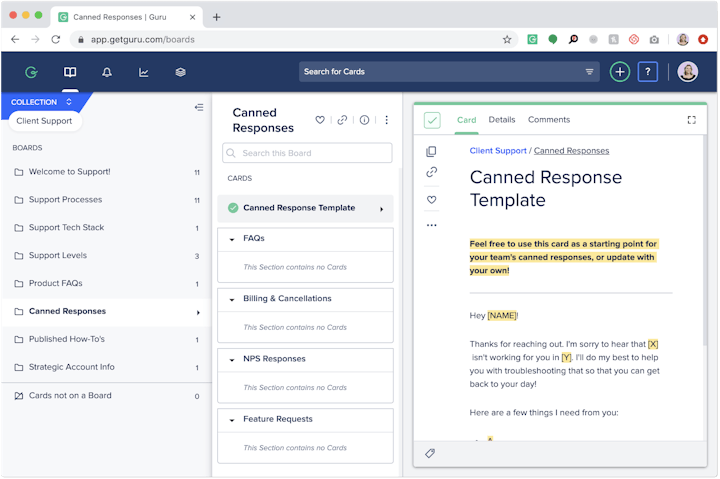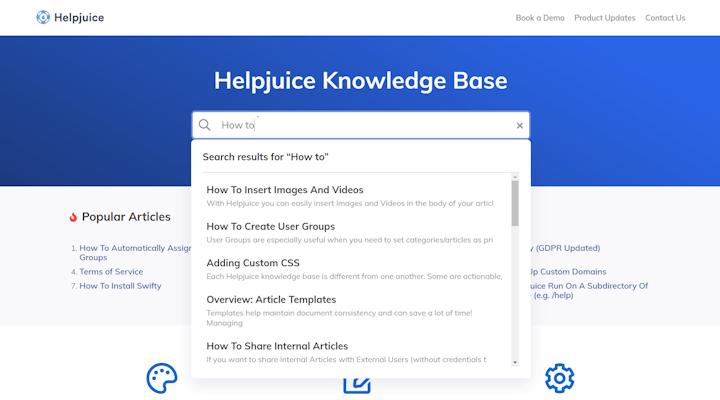The 12 Best Knowledge Base Software (2023)


We all know the old axiom “knowledge is power.” And though it’s true, there’s a caveat: In order to unlock the power of any knowledge, people first need access to it.
Access to knowledge is an issue many organizations face. They have information to share with employees, customers, and the public, but they don’t always have an effective means by which to share it. Luckily, there’s a tool that addresses that very issue: knowledge base software.
What is knowledge base software?
Knowledge base software, also commonly referred to as help center software, is a tool that helps you create, organize, and manage self-service content for an audience. Essentially, a knowledge base lets you provide people with helpful content so that they can easily find information on their own without having to reach out to other employees or your customer support team for help.
Knowledge bases created by a business typically house frequently asked questions (FAQs), video tutorials, and how-to articles, but it’s not uncommon for individuals to create knowledge bases for personal use as well. A personal knowledge base might include things like notes, research for a project, journal entries, etc.
The 12 best knowledge base software platforms
Whether you’re looking to create a help center or wiki or are just looking for a way to organize your work notes, here are 12 knowledge base software platforms worth checking out.
Help Scout
Guru
Document360
Obsidian
HelpJuice
Zendesk
BookStack
inSided
Notion
Confluence
Bloomfire
MediaWiki
1. Help Scout
Best combined help desk and knowledge base software.
Help Scout is a complete customer service platform, and one part of the platform is our knowledge base software, Docs. Docs is flexible, easy-to-use knowledge base software that lets you create beautiful knowledge base articles in minutes using a text editor that offers multiple formatting options in both WYSIWYG and HTML.
You can quickly upload images and videos to articles to make content even better, and soon you will be able to use our new feature, AI assist to adjust your article's tone, length, or even translate it into additional languages like Spanish, German, and Chinese.
Help Scout users also get access to Beacon, our versatile web widget. With Beacon, you’re able to embed a chat-style widget on any page of your site or app so visitors have direct access to your knowledge base library without ever having to click away from the page they’re on.
Docs also integrates seamlessly with our shared inbox. Agents can share links to knowledge base content directly in customer email conversations without needing to do any copying and pasting, which reduces response times and hassle.
Finally, Docs is built for SEO, making it easy for your team to create content that ranks highly in Google's search engine, so your customers can find the answers they need wherever they look.
Best of all, when you sign up for Help Scout, you get access to the entire customer support platform for about the same cost as most stand-alone knowledge base software — and often at an even lower cost.
Price: Free trial available. Plans start at $20/user per month.
Discover the power of self‑service
Create and publish answers for customers and reduce your customer support volume by at least 20% with Help Scout Docs.
Start a free 15-day trial
2. Guru
Best internal knowledge base software.

Guru is an internal wiki and knowledge management solution that allows you to store all of your company information in one place. Whether it’s battle cards for your sales team or product roadmaps for engineering, you can store it all in Guru.
The platform offers a browser extension, allowing users to capture and store information easily without needing to switch windows or applications. They also have a Slack integration that can be used to create articles, find or share existing information, and send real-time notifications when content requires verification or has fallen out of date.
Price: Free trial and plan available. Paid plans start at $5/user per month.
3. Document360
Best free knowledge base software.
If you’re looking for stand-alone knowledge base software, Document360 could be a good option. It has a user-friendly interface, the ability to compose using a markdown or WYSIWYG editor, search capabilities, and you’re able to create both internal and external knowledge bases using the tool.
The platform offers a free plan that could be a great starting point for small businesses looking to create a public-facing knowledge base. The plan includes five team accounts (user seats), one GB of storage, and 50 articles, and it allows your team to create a Document360 domain for your knowledge base site. One downside to the free plan, however, is that it only supports public knowledge bases — those looking for an internal knowledge base solution will need to look to the software’s paid plans.
Price: Free trial and plan available. Paid plans start at $99/project per month (includes five team accounts).
4. Obsidian
Best personal knowledge base software.

Obsidian is a knowledge base solution that is great for personal use. While most options on this list are cloud based, Obsidian’s Personal plan stores all of your data locally on your device. The files are written in markdown, making the source files easy to read and edit. Your content is also accessible offline, making it possible to work even when your internet connection is spotty.
For those who prefer to have access to their notes across devices or want to publish certain articles publically, Obsidian offers Sync and Publish add-ons. These features do require cloud-based data access and come with a monthly fee.
Obsidian’s Personal plan is free for non-commercial users, though users who wish to support the software’s development can make a one time payment of $25 to receive early access to new builds. Commercial licenses are also available for businesses employing two or more people.
Price: Free trial and plan available. Commercial plans start at $50/user per year.
5. HelpJuice
Best stand-alone self-service knowledge base software.

HelpJuice is a stand-alone knowledge base software product that focuses heavily on design and collaboration tools. Through its editor you’re able to edit typeface, layout, and colors to match your brand aesthetic. The editor also allows authors to drag and drop files and images into article drafts and copy and paste from Word docs while maintaining the copy’s formatting.
Another interesting editor feature is the ability to display different troubleshooting steps in the same article based on reader input. For instance, if someone wants to know how to perform a task on their computer, you can add separate steps for PCs and Macs within the same article, and HelpJuice will ask the reader which operating system they're using and only display the relevant information.
HelpJuice’s collaboration features are also worth mentioning. Teams can work on article drafts together, leaving comments throughout the drafting process. Lastly, the platform has versioning abilities and boasts a number of integrations, making it a good choice for both internal and public-facing audiences.
Price: Free trial available. Plans start at $120 per month (includes up to four users).
6. Zendesk
Best knowledge base software for enterprise companies.

Zendesk is help desk software that includes a knowledge base tool called Zendesk Guide. Guide has a lot of positive features such as a WYSIWYG style editor, a drag-and-drop interface for structuring your help center, the ability to create content for both internal and external audiences, a web widget for displaying articles in-app or on your website, and analytics that help you understand how your content is performing and where knowledge base gaps may exist.
While Zendesk Guide makes it easy to get up and running, it also has its downsides. The interface is customizable; however, the amount of free help center themes are extremely limited. Additional themes are available within the Zendesk Marketplace, though their price tags can be rather high. Another area where Guide falls short is versioning — only higher-tiered Zendesk Suite plans offer versioning, which can make it difficult to publish article updates that coincide with product or service releases.
Price: Free trial available. Plans including Zendesk Guide start at $49/agent per month.
7. BookStack
Best open source knowledge base software.

BookStack is a free, open source, self-hosted knowledge base platform. It has a simple interface and lets users choose between a WYSIWYG or markdown content editor.
When it comes to organization, the software allows you to structure your knowledge into three color-coded groups: books, chapters, and pages. In this hierarchy, books are your broad categories, chapters are subcategories, and pages are the individual articles. Once you have several “books,” they can be further organized onto bookshelves.
Content on BookStack is fully searchable and the platform has powerful features like multi-lingual support, dark and light modes, role permissions, and an integration with diagrams.net which makes it easy to add diagrams to your documentation.
Price: Free
8. inSided
Best knowledge base software for building community.
inSided is a community platform that lets your customers connect with one another. Access to that collective knowledge can help reduce incoming requests for your team, and it also gives customers another channel to access when they have questions.
With inSided you can build out a standard knowledge base and offer on-page and in-app support using their embeddable widget. The platform also offers tools for collecting product feedback and facilitating customer communication, helping you better understand the needs and wants of your users.
Price: Contact for pricing.
9. Notion
Best knowledge management system for SaaS companies.

One of the leaders in internal knowledge bases is Notion. Their core benefit is how flexible the tool is: You can make kanban boards, checklists, and text documents. You can also assign tasks to other users and set due dates for tasks. It’s basically an internal wiki plus a project management tool.
Notion does offer a free plan, but it’s only for personal use. If you want to have multiple collaborators (which is where their value really shines), you have to be on their Plus, Business, or Enterprise plan.
Price: Free trial and plan available. Paid plans start at $8/user per month.
10. Confluence
Best knowledge base solution for companies using Jira.

Confluence is very similar in look and function to Notion. The platform is focused on internal use and project management and comes with an extensive library of page templates so you can get started quickly.
You’re also able to create team spaces to keep things organized and set permissions for different articles. Confluence integrates seamlessly with other Atlassian products, making it a great choice for teams already using products like Jira and Trello.
Price: Free trial and plan available. Paid plans starting at $5.75/user per month.
11. Bloomfire
Best knowledge base platform for companies that prefer to create video content.
Bloomfire is an internal knowledge-sharing platform designed to assist employees in quickly finding the information they need. A unique feature of its software is its AI-powered search engine that can transcribe videos.
You can also create custom questions and answers, then turn both into searchable content that can be liked and shared by other users, mimicking a type of social media.
Bloomfire’s plans start at 50 users, so it may not be the best choice for smaller companies.
Price: Contact for pricing.
12. MediaWiki
Best self-hosted knowledge base software.
MediaWiki will look familiar to most as it is the platform that the internet’s most famous wiki, Wikipedia, is built on. The user interface is clean and easy to read and navigate, and content is written in wikitext format so that users can edit content without any HTML or CSS knowledge.
One thing to be aware of with MediaWiki is that it is designed for open content, so it’s not a great choice if some of your content needs to be gated. In addition, as it was designed to serve high-traffic websites, it may not be the right fit for smaller sites where disk or memory space are a concern.
Price: Free
What are the different types of knowledge base software?
There are two different categories of knowledge bases: internal and external. Internal knowledge bases require login credentials to access information, while external knowledge bases are written for the public.
Beyond who can access the information, internal and external knowledge bases each cater to different use cases:
Internal knowledge bases are only accessible to employees or other parties within an organization. They typically include information like employee handbooks, org charts, company directories, operating procedures, and internal-facing documentation for products and services.
External knowledge bases are made for both customers and the general public. They might contain answers to FAQs, company contact information, and troubleshooting steps for products.
Knowledge bases also vary depending on how the content is created, viewed, and maintained. For instance, some knowledge base types are collaborative while others are designed to be more unilateral.
Here are a few knowledge base types to consider:
Shared files: While most people think of something more formal, it’s possible to maintain a knowledge base in a series of files (e.g., Word or Google Docs) that are shared with those who require access.
Intranet: An intranet is a private, secure network that can only be accessed by members of an organization. Intranet software is often used by enterprise companies for sharing information, communicating, and collaborating with employees.
FAQ pages: An FAQ page is a web page that lists answers to common questions often posed to an organization.
Help center: A help center is a website that acts as a hub for an organization’s stored knowledge. It is typically searchable and often comes with content management and reporting functionalities. A help center can be used as an internal or external knowledge base, depending on the user role and permissions available as part of the software.
Wiki: A wiki is an online knowledge base that is created and maintained collaboratively by its users. Though roles and permissions may exist depending on the platform, most wikis allow any user to add, edit, or delete content.
There can also be differences in how knowledge base data is stored. Knowledge base software can either be self-hosted or it can be offered as a Software as a Service (SaaS) solution.
Self-hosted: When a knowledge base is self-hosted, an organization either purchases a software license or uses free, open-source software to set up a knowledge base on their own server (sometimes referred to as “on-premise”) or in a private, cloud-based environment (e.g., Amazon Web Services, etc.). Self-hosted software can be great for businesses that need to keep close control of their data, but they also require more maintenance and technical expertise.
Software as a Service (SaaS): Many knowledge base software options are SaaS products, meaning that a company creates and hosts the software and makes it available to users over the internet, typically as part of a subscription plan. SaaS software doesn’t allow users to have as much control over their data, but it has other advantages such as increased accessibility.
Help desks vs. knowledge bases: What’s the difference?
Those looking to build an external knowledge base for their customers may wonder what the difference between a help desk and a knowledge base is. After all, many help desk products include a knowledge base builder as part of their feature set.
To understand the differences and which might be best for you, we should start by defining our terms:
Help desks (or ticketing systems) are software platforms that help customer support or information technology (IT) teams manage incoming user requests.
Knowledge base software helps you create, maintain, and publish content for a specific audience.
Each tool focuses on a specific type of support. Help desks are designed to handle reactive support, whereas knowledge bases are intended to provide proactive support:
Reactive support is managing and responding to people’s questions or requests.
Proactive support is the process of providing people with the information they need before they ask for it.
In most situations, support and IT teams will benefit from using the knowledge base included with their help desk. This will allow them to provide reactive and proactive support using one solution and to measure their efforts holistically.
On the flip side, if your company doesn’t receive many customer contacts or isn’t ready for a ticketing system, then a stand-alone knowledge base tool could be a great way to provide some initial proactive support and boost your company’s SEO.
Outside of customer support, stand-alone options are also ideal for company-wide internal knowledge bases that hold information like your employee handbook and operating procedures.
Why do you need knowledge base software?
Though it may be possible to get away without a formal knowledge management system for a while, the approach isn’t sustainable. Most internal or external issues will come up more than once, and documenting processes and publishing answers to customer FAQs can save your team time and money.
Knowledge bases:
Improve employee onboarding and training: New hires benefit from access to both internal and external knowledge bases. Onboarding is much easier when company policies and processes are documented and made accessible.
Boost team productivity: Customer-facing knowledge bases can help your support and success teams quickly track down answers and resources when working with customers.
Reduce customer contact volume: Knowledge bases help people find the information they need on their own, reducing the strain on your team.
Provide a positive effect on SEO: Articles in your external knowledge base can be optimized for search, increasing the chance of ranking higher in search engine results. This helps the public find the answers they need and can help you acquire new customers as well.
Are what your customers want: People like to be able to help themselves! A Zendesk report found that “63% of customers always or almost always start with a search on a company’s online resources when they have an issue.”
There are also several benefits to using knowledge base software vs. creating a FAQ page on your website or relying on a shared document.
Knowledge base software is:
Easy to set up and maintain: Building a website on your own requires some technical know-how, even when using a template. Most knowledge base software is ready to use out of the box — choose a theme, tweak the color palette, add your content, and you’re ready to go.
Full of useful features: Knowledge base software has features that a webpage or a shared document doesn’t have, such as robust search features, web widgets for providing proactive support throughout your user experience, and integrations with other tools in your tech stack.
Built for collaboration: Knowledge base software makes the process of maintaining documentation run more smoothly.
Based on the reasons above, it is obvious that a knowledge base, be it internal or external, is something that could benefit any business.
Knowledge base software features: What to look for
While knowledge base software features vary from platform to platform, here are ten features to look for during your search:
A user-friendly editor: Most editors feature a WYSIWYG interface, with some offering additional options for creating content using markup and HTML.
Easy navigation: Look for software that allows you to organize your knowledge base articles logically and in a way that places popular content front and center for the reader.
Search functionality: Your knowledge base should have a strong search engine and features like tagging to help optimize its results.
Features for collaboration: If multiple users will create and maintain the content, look for features that will help you work together, such as collaborative drafts.
Article versioning: Your software should have article versioning features that allow you to see who has made changes to an article, what changes were made, and provide the ability to revert to another version.
User roles: Having the ability to assign permissions to each of your team members will ensure that each person has the right amount of access.
Customizable UI: Look for software that will let you update the color palette, choose a font, and upload a company logo. If you need more advanced customizations, look for a platform that will let you make additional tweaks using CSS and HTML.
Web widget: Adding a web widget to your site can help provide proactive support throughout your customer experience, increasing user satisfaction and reducing contact volume for your team.
Integrations: Seek out software that integrates with software platforms that you already use.
AI tools: Many tools offer AI features that can help simplify your content creation and knowledge management processes.
Reporting: Reporting dashboards show how content performs and can help you make data-driven decisions when deciding what content to update or add to your knowledge base.
How to choose the right knowledge base software
Which knowledge base software is best? It depends on the software environment you are in, the capabilities you need (or want), and the resources you have available. Here are some key questions to help you narrow down the options:
Do you need just one knowledge base, or do you need several separate ones? How does the tool handle multiple knowledge bases?
How many people will be authoring or updating content?
Can the knowledge base software display content in-app? Or will customers need to click through to another page?
Can the design of the knowledge base pages be customized, and what skills will you need to do it?
How does the search function work?
What kind of reporting does the knowledge base software include?
When you have a short list you are considering, be sure to spend some time using the company’s own knowledge base (and contacting their support team). They should be the best example of their own capabilities!
Here are a few additional things to consider.
Value
Measuring value is asking the question “Is this worth what I’m paying for it?”
For example, $300 may sound like a lot for a pair of pants, but what if they came with a guarantee to be tailored to fit you perfectly and replaced for the rest of your life any time you needed it? All of a sudden, $300 doesn’t sound so bad.
With knowledge base software, comparing tools based on value instead of cost can make things a lot clearer. For example, two options might have the same cost, but if one gives you access to other tools along with knowledge base capabilities, it probably holds a lot more value, making it the better choice.
Flexibility
There are a couple of ways to think about flexibility.
First, you can consider how many separate functions a tool can perform. With knowledge base software, you might think about whether it’s useful for both internal and external knowledge bases. You could also think about how well it integrates with other tools you might use in conjunction with it.
Second, you can consider how well a tool will grow with you and your needs as time goes on — there should be a balance between buying for now and for the future.
If you’re a team of five, buying for the possible future of being a team of 500 may not be pragmatic. But buying a tool that can cover your needs for the next 12-18 months is probably a smart move.
Ease of use
The simple truth of any software is this: If it’s hard to use, no one is going to use it. That applies to both those using it internally and those using it externally.
With knowledge base software, you need to consider the experience of creating and maintaining a piece of content as well as the experience of finding and interacting with content as a user.
The only way to really know how easy or difficult something is to use is by actually using it. After you’ve made a short list of options, do a trial of each. Getting hands-on experience with a product will give you way more insight than any demo ever could.
You should also ask to see existing examples of knowledge bases created using their software. That way you can get a better idea of how a customer would experience interacting with the product.
Buyer’s Guide to Choosing the Right Customer Support Tool
Tailored to help you identify your customer support needs, this guide will help you find the right solution, simplify your purchase decision, and get leadership buy-in.
Get the guide
The importance of knowledge base design
Now that you’ve found the tool that best meets your needs, it’s time to build your knowledge base.
While it may be tempting to start typing up and publishing articles right away, putting a little extra thought into how you present information to your customers or employees will help ensure that they get the most out of the resource.
Here are some guidelines to consider as you design your help center:
Keep your branding consistent. Use the same colors, fonts, and logos across your website and knowledge base. This will let your reader know that they’re in the right place.
Design with the user in mind. Organize your content logically, prioritize popular resources, place a search bar in a prominent location, and tag your articles to help ensure that readers can easily find the information they’re looking for.
Write for your reader. Put together clear, concise documentation in the language and tone used by your audience. Steer clear of jargon and avoid terms that would be unfamiliar to the reader.
Format your articles for readability. Most people who read content on the web scan the text to find the information they need. Use headings, lists, white space, images, videos, and callouts to improve the readability of your articles.
Build your content on data. Start your knowledge base off with articles that only answer known FAQs. Then, as readers interact with your content, use the data from your software’s reporting feature to determine what information should be updated or added to better serve your reader’s needs.
Build a knowledge base with accessibility in mind. Try to follow Web Content Accessibility Guidelines (WCAG) when possible. Things like adding alt text to images and providing meaningful link text to your articles can go a long way in helping others get the most from your content.
Finding the right solution
Investing in a new tool is always a big decision. It takes time, money, and energy, so there’s a lot of pressure to get it right. Make sure you define your needs and goals upfront. As you learn more about different products, they may shift some, so you need to be a bit flexible, too.
When you’re reviewing options, be critical, get feedback from others, and take your time. It may feel overwhelming at times, but as long as you have a solid game plan, we’re confident you’ll make the right choice.
Discover the power of self‑service
Create and publish answers for customers and reduce your customer support volume by at least 20% with Help Scout Docs.
Start a free 15-day trial
Did you know that we also have this guide available in German and French?
The Supportive Weekly: A newsletter for people who want to deliver exceptional customer service.








